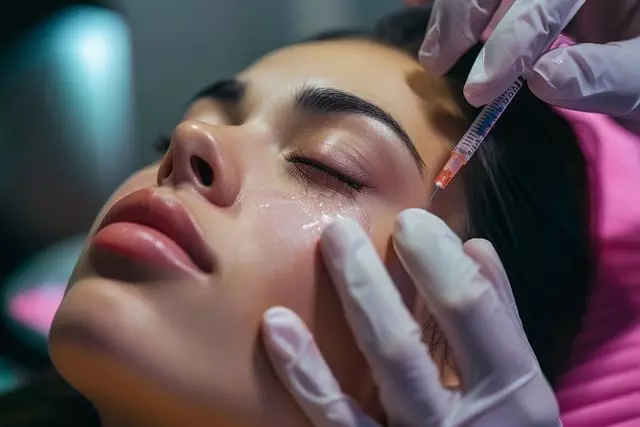Botox for facial contouring, derived from Clostridium botulinum, temporarily paralyzes muscles to reduce dynamic wrinkles and enhance facial features non-surgically. Popular among individuals aged 25 and above with mild to moderate sagging, it offers quick (15-30 minute) procedures with minimal downtime. Results last 3-6 months, requiring regular treatments. Ideal candidates should consult a qualified dermatologist for an assessment, considering medical history, medications, allergies, and realistic expectations. Potential side effects include temporary bruising or swelling, while rare cases may present headaches or muscle weakness.
“Discover the transformative power of Botox in achieving a youthful, lifted appearance without surgery. This comprehensive guide explores how Botox, a popular neurotoxin, plays a pivotal role in facial contouring. Learn about its benefits in reducing wrinkles and redefining facial lines, as well as the science behind its effect on skin and muscles. We’ll delve into candidacy, procedure details, expected results, maintenance, and potential side effects, providing insights for those considering Botox for Facial Contouring.”
Understanding Botox and Its Role in Facial Contouring

Botox, a protein derived from a bacterium called Clostridium botulinum, has gained significant popularity in the realm of aesthetic medicine. When injected into specific muscles, Botox can temporarily paralyze them, leading to a reduction in dynamic wrinkle formation. In the context of facial contouring, this becomes a powerful tool for achieving a more youthful appearance by smoothing out fine lines and wrinkles around the eyes, forehead, and mouth—areas that are particularly prone to the effects of aging.
Its role extends beyond just reducing wrinkles; Botox can also be strategically injected to elevate and define facial features. By relaxing certain muscle groups, it allows for the redistribution of fat, creating a more chiseled jawline, defined cheekbones, or lifted eyebrows—all desirable outcomes in facial contouring treatments. This non-surgical approach offers a temporary yet effective solution for those seeking subtle enhancements without the downtime associated with surgical procedures.
Benefits of Botox for Non-Surgical Face Lift

Botox has emerged as a popular, non-surgical option for facial contouring, offering multiple benefits to those seeking a youthful appearance. One of its key advantages is the ability to relax and prevent muscle contractions that contribute to wrinkles and fine lines. By injecting Botox into specific facial areas, practitioners can reduce the visibility of dynamic wrinkles, providing a more smoothed and lifted look.
This treatment also provides a less invasive alternative to traditional face lifts. It does not involve incisions or extensive surgery, making it an appealing choice for individuals who prefer minimal downtime and reduced recovery risks. Additionally, Botox for facial contouring can be tailored to individual needs, allowing for precise adjustments to achieve a natural, rejuvenated look that enhances overall facial harmony.
The Science Behind Botox's Effect on Skin and Muscles

Botox, a protein derived from bacteria, has an intriguing science behind its powerful effects on skin and muscles, making it a popular choice for facial contouring treatments. When injected into specific facial areas, Botox temporarily paralyzes the underlying muscle fibers responsible for causing dynamic wrinkles and lines. This action prevents the contraction of these muscles, leading to a reduction in the depth and appearance of wrinkles over time.
The scientific precision of Botox for facial contouring lies in its ability to target certain muscle groups without affecting other nearby tissues. This results in a non-invasive procedure that enhances facial aesthetics naturally. As a neurotoxin, Botox blocks nerve signals to muscles, thereby reducing their activity and allowing the skin to appear smoother and more youthful. Its effects are not permanent, providing patients with control over the process and the ability to maintain natural expressions while achieving desirable facial contouring results.
Candidacy and Considerations for Botox Facial Contouring

Botox for facial contouring is a popular non-surgical procedure that can significantly enhance facial appearance by relaxing muscles and reducing wrinkles. Ideal candidates are individuals aged 25 and above with mild to moderate facial sagging, frown lines between the eyebrows, or crow’s feet around the eyes. It’s crucial to consult a qualified dermatologist or medical professional for an in-depth assessment to determine eligibility.
Several considerations come into play when contemplating Botox for facial contouring. Medical history, current medications, and any allergies should be disclosed. Additionally, realistic expectations are vital. While Botox can dramatically improve facial appearance, it’s essential to understand its temporary nature, typically lasting 3-6 months, requiring regular treatments for sustained results.
The Procedure: What to Expect During a Botox Treatment

During a Botox for facial contouring treatment, a healthcare professional will begin by cleaning and preparing your skin. They’ll then use fine needles to inject small amounts of Botox into specific muscles in your face. The process is typically quick, with each session usually lasting between 15-30 minutes. You may feel a brief pinch or stinging sensation at the injection sites, but it’s usually well-tolerated. After the procedure, you can return to your normal activities immediately, though you might experience mild redness or swelling for a few hours. It’s important to remember that Botox treatments require regular maintenance, with recommended scheduling varying based on individual results.
Results, Maintenance, and Potential Side Effects

Botox for facial contouring offers immediate and noticeable results, temporarily smoothing fine lines and wrinkles to provide a more youthful appearance. As treatment effects subside over several months, maintenance sessions are typically required to sustain the desired aesthetic. Regular Botox injections can help delay the need for more invasive procedures like facelifts.
While generally considered safe, Botox for facial contouring carries potential side effects, such as temporary bruising, swelling, or discomfort at the injection site. In rare cases, patients may experience headaches, muscle weakness, or vision disturbances. Promptly reporting any unusual symptoms to a qualified healthcare provider is essential for effective monitoring and management.
